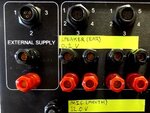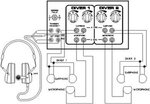RMunoz
Newbie level 3

I would like to connect a standard 4 wire (full duplex) communications box, used in surface supplied diving operations, to:
1) A standard TRS-Type 3.5mm (1/8") jack on a mobile phone
2) The two (mic and speaker) standard TRS-Type 3.5mm (1/8") jacks on a computer
The binding post on the "comms box" I want to connect to is standard for most surface supplied diving operations (Photo 1). Two black binding posts (0.1V) are used for connecting the two wires used for the divers speakers. Two red binding posts (12V) are used for connecting the two wires used for the divers microphone (Photo 2 for basic wire diagram).
I already know I can connect it to a telephone. I cut the wire between the telephone handset and base. When I hooked the telephone handset to the "comms box" using the binding post I was able to carry on a conversation. The volume from the microphone was very low and easily drowned out by anyone else patched into the "comms box." I also attached the binding post to the telephone base. I was able to make a phone call but there was an overpowering high pitch background noise that made communication unpleasant.
I have very little background with electrical circuits and was hoping to purchase something off the shelf or some easily assembled solution. I have soldered once or twice and have access to a digital multimeter.
Any other sites where I might post this are also welcomed. Some additional specifications from the product's manual are:
Operating Voltage: 12 V DC recommended (Between 7 and 16 V DC allowed)
Idle Current: 0.29 Amps
Max Overload Current: 3.0 Amps
Audio Output Power: 8 watts max
Audio Output Protection: Over load and short circuit
Maximum Output Voltage: 7 VRMS @ 12 V supply
Microphone impedance: 100 ohm
Microphone: Dynamic microphone or preamp microphone
Thanks for the help. If this works, any Ipod recommendations for diving music would be welcomed.


1) A standard TRS-Type 3.5mm (1/8") jack on a mobile phone
2) The two (mic and speaker) standard TRS-Type 3.5mm (1/8") jacks on a computer
The binding post on the "comms box" I want to connect to is standard for most surface supplied diving operations (Photo 1). Two black binding posts (0.1V) are used for connecting the two wires used for the divers speakers. Two red binding posts (12V) are used for connecting the two wires used for the divers microphone (Photo 2 for basic wire diagram).
I already know I can connect it to a telephone. I cut the wire between the telephone handset and base. When I hooked the telephone handset to the "comms box" using the binding post I was able to carry on a conversation. The volume from the microphone was very low and easily drowned out by anyone else patched into the "comms box." I also attached the binding post to the telephone base. I was able to make a phone call but there was an overpowering high pitch background noise that made communication unpleasant.
I have very little background with electrical circuits and was hoping to purchase something off the shelf or some easily assembled solution. I have soldered once or twice and have access to a digital multimeter.
Any other sites where I might post this are also welcomed. Some additional specifications from the product's manual are:
Operating Voltage: 12 V DC recommended (Between 7 and 16 V DC allowed)
Idle Current: 0.29 Amps
Max Overload Current: 3.0 Amps
Audio Output Power: 8 watts max
Audio Output Protection: Over load and short circuit
Maximum Output Voltage: 7 VRMS @ 12 V supply
Microphone impedance: 100 ohm
Microphone: Dynamic microphone or preamp microphone
Thanks for the help. If this works, any Ipod recommendations for diving music would be welcomed.


